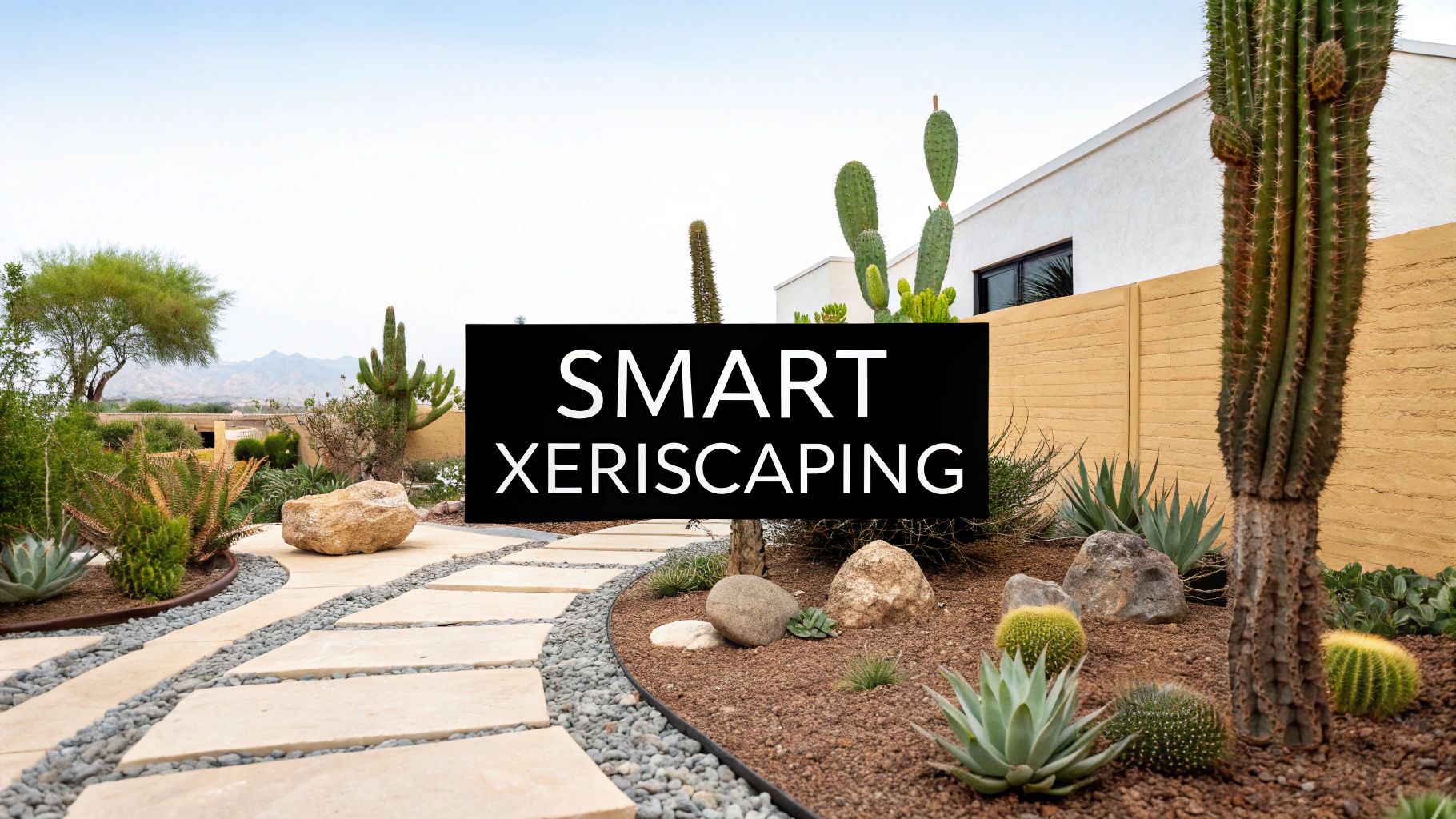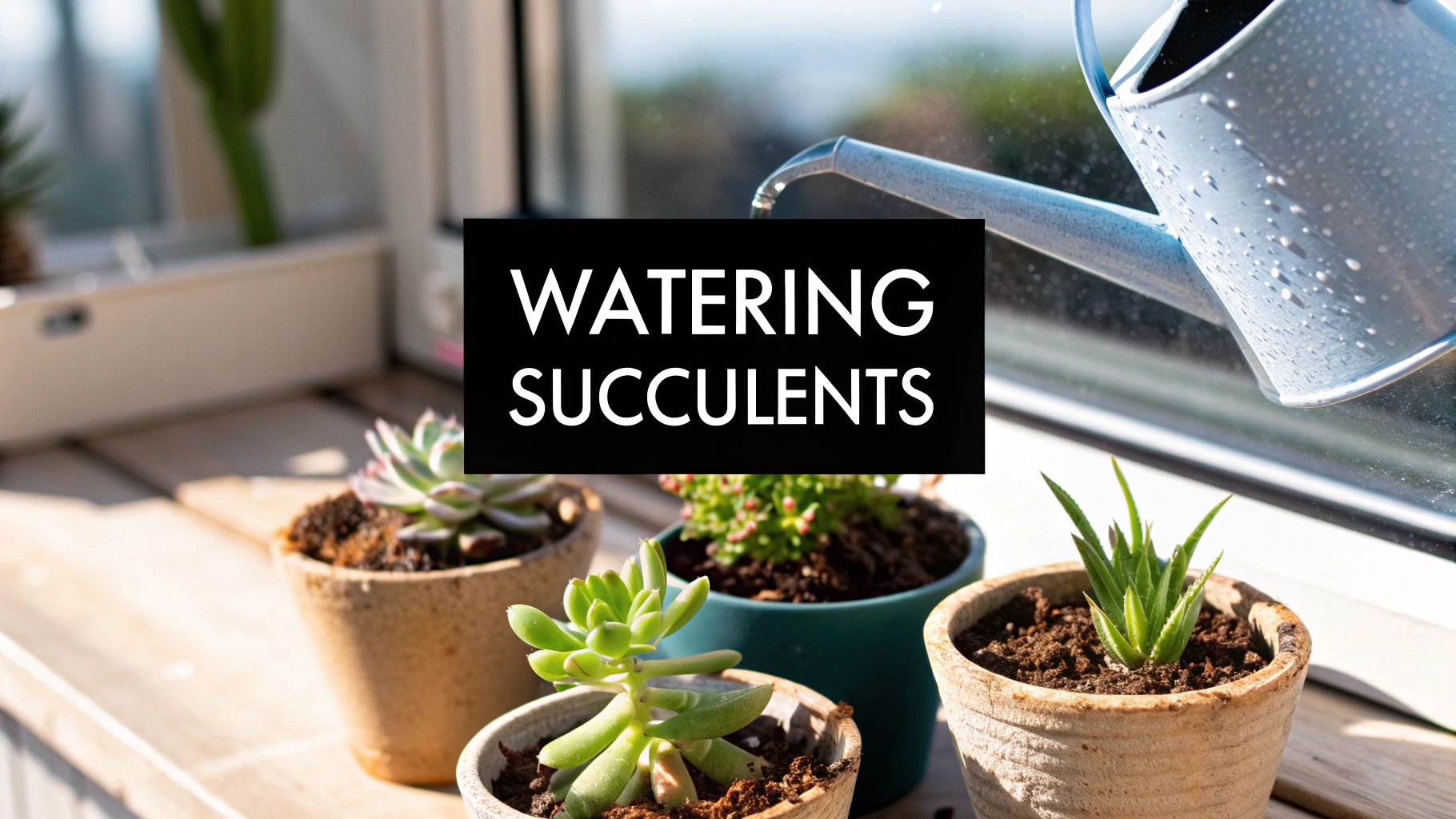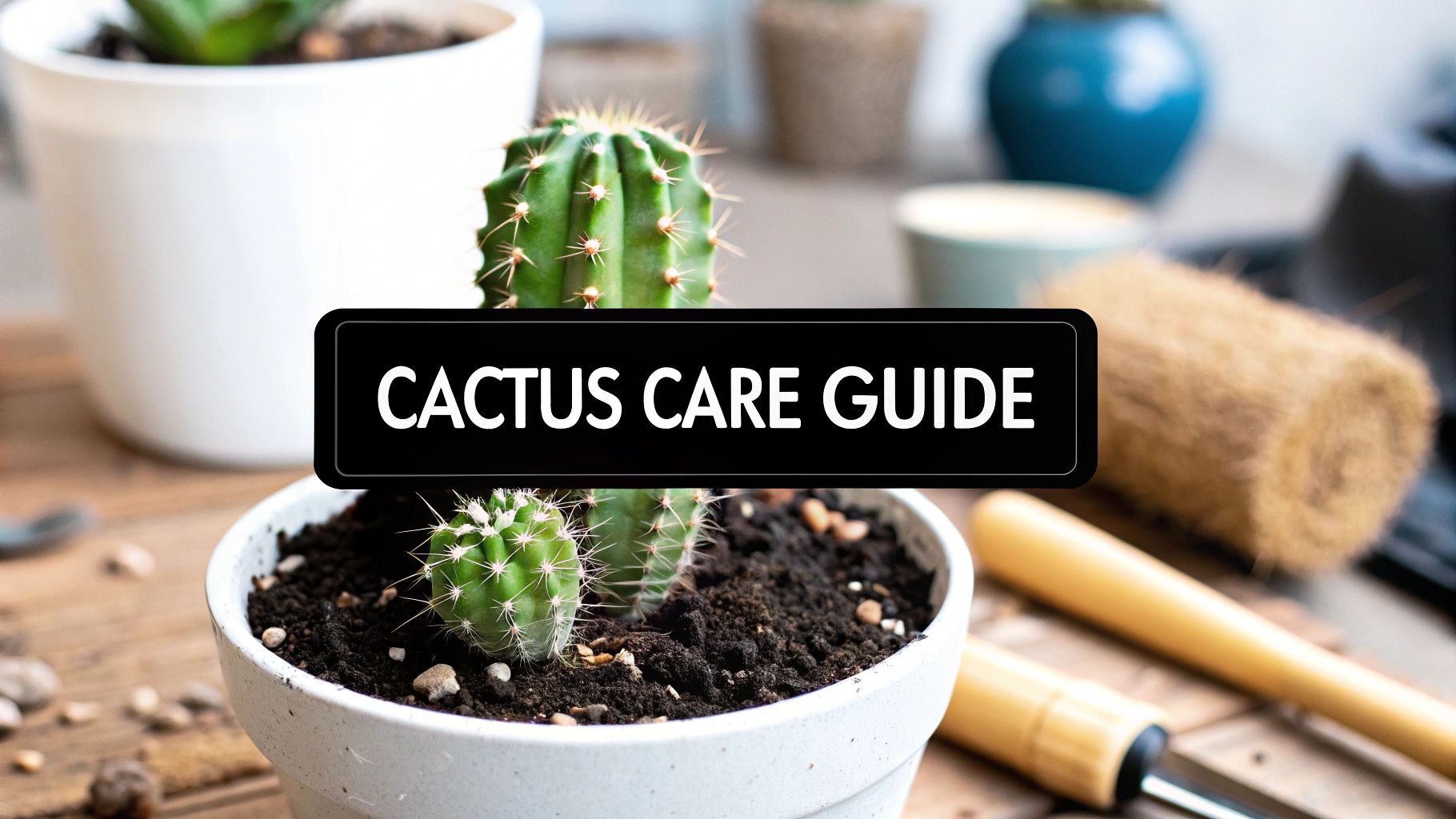As climates shift and water becomes an increasingly precious resource, the traditional green lawn is evolving from a suburban staple into an unsustainable luxury. A water-wise yard, however, does not have to be a barren one. This guide moves beyond basic advice to explore 10 innovative and beautiful drought tolerant landscaping ideas designed to save water, slash maintenance time, and create visually stunning outdoor environments. We will delve into specific, actionable strategies that prove sustainability and sophisticated design can coexist harmoniously.
From the architectural elegance of a dedicated cactus garden, featuring unique specimens from The Cactus Outlet, to the rugged appeal of hardscaping with permeable materials, these concepts offer practical solutions for a changing world. This listicle is structured to provide clear, step-by-step insights for transforming your landscape. Whether you are contending with stringent water restrictions or are proactively seeking a more resilient, eco-friendly garden, you will find the tools and inspiration needed to cultivate a thriving, low-water oasis. Prepare to rethink what a garden can be.
1. Xeriscaping: The Original Smart Landscaping Philosophy
Xeriscaping is more than just a landscaping style; it's a comprehensive philosophy designed for water conservation without sacrificing beauty. Coined by the Denver Water Department in 1981, the term combines the Greek word 'xeros' (dry) with 'landscaping'. This approach creates sustainable, visually appealing outdoor spaces that can use 50-75% less water than traditional grass lawns. It’s a foundational concept among drought tolerant landscaping ideas, proven effective in diverse climates.
The success of xeriscaping is visible in public and private spaces nationwide. Denver Botanic Gardens features stunning demonstration gardens, while Las Vegas's turf removal programs have saved billions of gallons of water. These principles are not just for arid regions; they represent a smart, sustainable approach for any homeowner looking to reduce water usage and maintenance. To put these water-saving philosophies into practice, explore inspiring DIY front yard ideas, including xeriscaping, for a practical approach.
Key Xeriscaping Principles
To implement xeriscaping effectively, focus on its seven core principles:
- Smart Planning & Design: Start with a detailed site analysis of sun exposure, soil type, and drainage.
- Soil Improvement: Amend soil with compost to improve water retention and provide nutrients.
- Efficient Irrigation: Use drip systems or soaker hoses instead of sprinklers to deliver water directly to plant roots.
- Appropriate Plant Selection: Choose native and low-water-use plants suited to your local climate.
- Practical Turf Areas: Limit lawn space to functional areas and consider drought-tolerant grass alternatives.
- Use of Mulches: Apply a 3-4 inch layer of organic mulch to reduce evaporation and suppress weeds.
- Appropriate Maintenance: Low-water landscapes require less mowing, fertilizing, and pruning.
This summary highlights the core data points of the xeriscaping philosophy, from water reduction to its key principles.
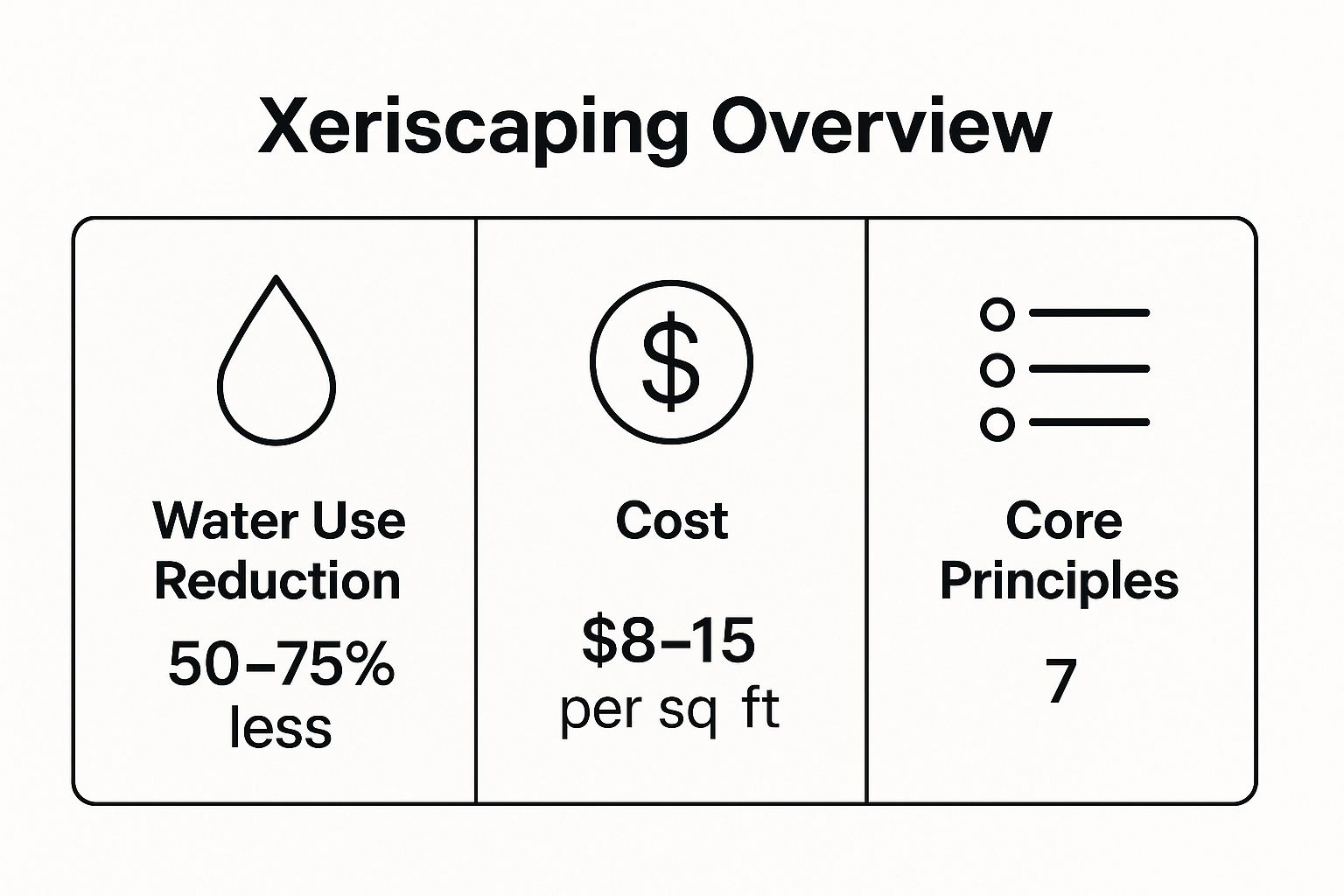
The data clearly shows that xeriscaping offers significant water savings by following a structured, seven-principle approach, making it an impactful and strategic choice for sustainable landscaping.
2. Native Plant Gardens
Native plant gardens are a powerful approach to sustainable landscaping, featuring flora indigenous to a specific geographic region. These plants have evolved over thousands of years to thrive in local soil and climate conditions, often without supplemental water, fertilizer, or pest control once established. This method works with nature, creating a self-sustaining ecosystem that supports local wildlife while requiring minimal human intervention, making it one of the most effective drought tolerant landscaping ideas.
The impact of native plantings is beautifully demonstrated across the country. The Lady Bird Johnson Wildflower Center in Austin, Texas, and Chicago's Lurie Garden showcase the stunning diversity of regional perennials. Even urban spaces like New York City’s High Line have successfully integrated native meadow plantings. These gardens prove that choosing plants adapted to your environment creates resilient, low-maintenance landscapes. For more ideas on plants suited to dry conditions, you can explore various drought-tolerant landscape plants.
Key Native Gardening Principles
To cultivate a successful native plant garden, focus on these core strategies:
- Site-Specific Research: Identify which plant communities naturally occurred on your site historically to guide your selections.
- Source Responsibly: Purchase plants from reputable native nurseries, avoiding specimens collected from the wild.
- Proper Planting Time: Plant in the fall to allow roots to establish over the cooler, wetter months before summer stress.
- Establishment Care: Water deeply but infrequently during the first one to two growing seasons to encourage deep root growth.
- Support Local Wildlife: Allow plant debris like seed heads and stalks to remain through winter as food and habitat.
- Start Small: Begin with a manageable area and choose easy-to-grow natives like coneflowers, salvias, or penstemons.
This summary highlights how native gardening creates a low-water, high-impact landscape that restores local ecosystems.
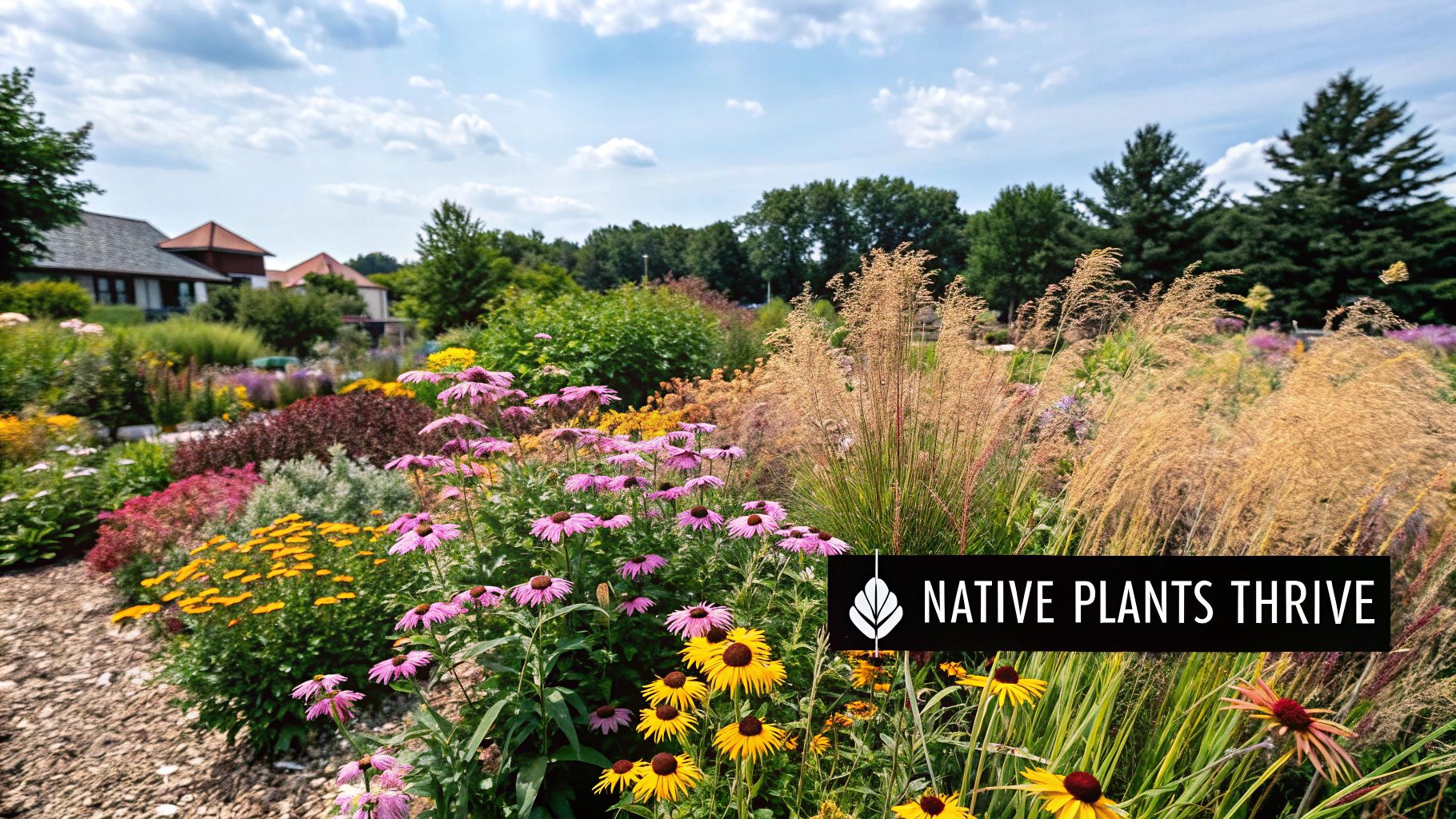
The data clearly shows that embracing native plants offers a sustainable, low-maintenance solution that conserves water while providing critical habitat for local fauna, making it a profoundly rewarding landscaping choice.
3. Succulent and Cactus Gardens
Succulent and cactus gardens are living sculptures, showcasing plants that have evolved to store water in their specialized tissues to endure long dry spells. These architectural plants create striking, modern landscapes with diverse textures, bold forms, and occasional dramatic blooms. They are a cornerstone of drought tolerant landscaping ideas, offering a practical and artistic solution that thrives on minimal water and maintenance.
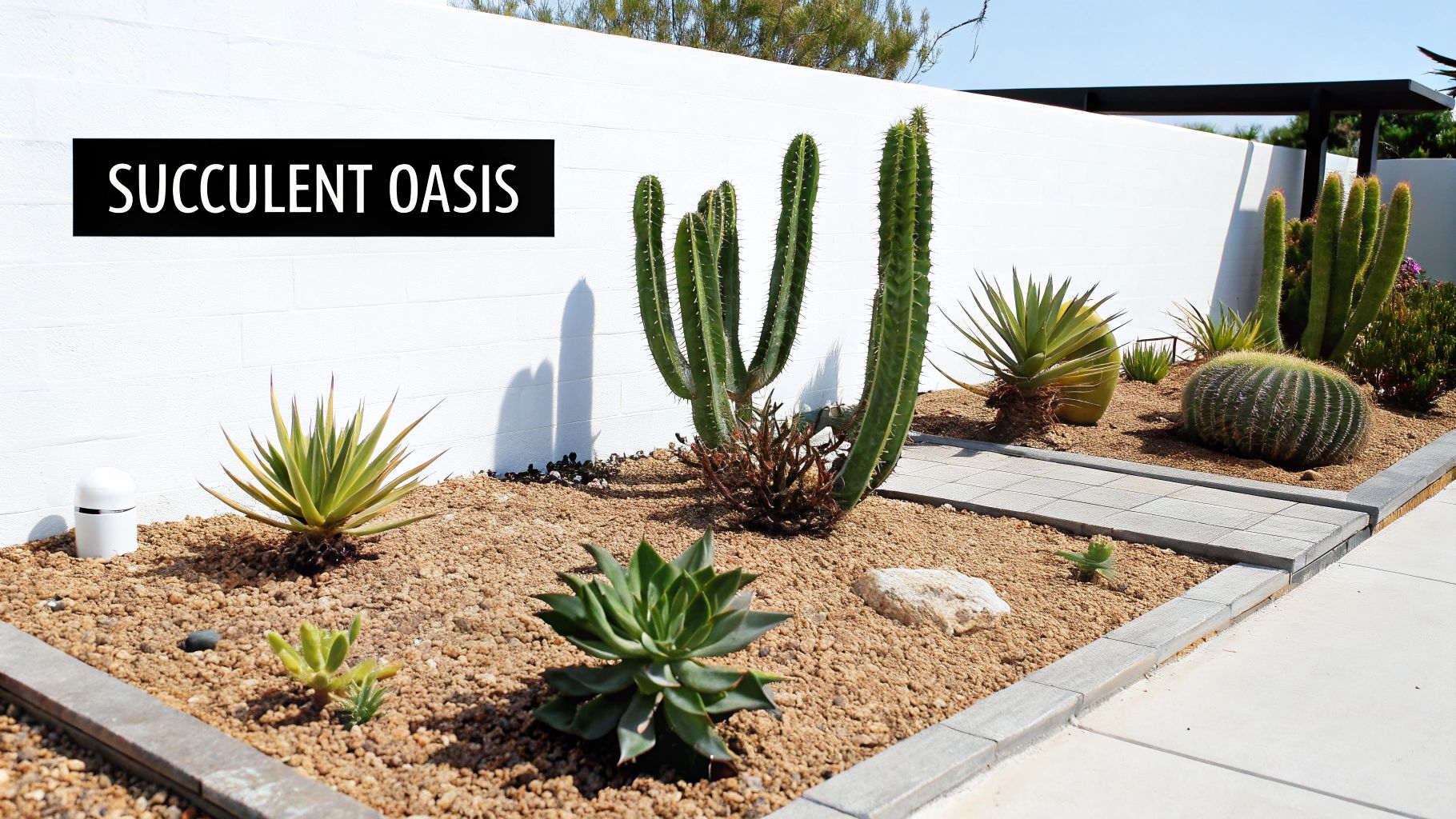
The stunning beauty of this approach is on full display at world-renowned locations like the Desert Botanical Garden in Phoenix and the Huntington Library's Desert Garden. These gardens prove that low-water landscapes can be incredibly lush and vibrant. Pioneered by figures like Ruth Bancroft, this style has become a popular choice for homeowners seeking a visually impactful yet sustainable outdoor space. The key is understanding their unique needs; for more guidance, see this detailed explanation of how to water succulents properly.
Key Tips for a Thriving Succulent Garden
To create a successful succulent and cactus garden, focus on recreating their native desert-like conditions:
- Ensure Excellent Drainage: Plant in raised beds or amend heavy soil with sand and pumice to prevent root rot.
- Group by Hardiness: Place plants with similar cold tolerance and sun requirements together for easier care.
- Water Deeply but Infrequently: Allow the soil to dry out completely between waterings, typically monthly in summer and rarely in winter.
- Use Inorganic Mulch: Apply decomposed granite or gravel mulch, which reflects heat and prevents moisture from collecting around plant crowns.
- Create Visual Interest: Combine different forms like columnar cacti, rosette-shaped echeverias, and sprawling ground covers for a dynamic design.
- Acclimate New Plants: Gradually introduce nursery-grown plants to full sun over several weeks to prevent sunburn on their leaves.
This summary highlights the core strategies for designing and maintaining a beautiful, water-wise succulent garden.
4. Artificial Turf Installation
Modern artificial turf is a highly engineered landscaping solution that provides the lush, green aesthetic of a traditional lawn without the intense water requirements. Made from synthetic fibers designed to mimic natural grass, today’s high-quality products offer realistic color variations and blade shapes, eliminating the need for watering, mowing, or chemical treatments. This approach is one of the most direct drought tolerant landscaping ideas for homeowners seeking to replace thirsty grass.
The effectiveness of artificial turf is proven in large-scale applications. Los Angeles schools have replaced grass fields, saving millions of gallons of water annually, while Las Vegas residential installations are widespread due to water authority rebate programs. It serves as a practical, always-green alternative in regions facing strict water restrictions, making it an excellent choice for high-visibility areas where a lawn's appearance is desired year-round.
Key Artificial Turf Installation Tips
To ensure a successful and long-lasting installation, focus on quality materials and proper preparation:
- Proper Base Preparation: A solid foundation is crucial. Ensure a 3-4 inch layer of compacted aggregate is installed for proper drainage and a smooth, even surface.
- Choose Quality Turf: Select products with a high face weight (60 ounces or more per square yard) for better durability and a more realistic look and feel.
- Select Appropriate Infill: Choose infill materials carefully, considering options like silica sand or specialized non-rubber alternatives to avoid potential health or environmental concerns associated with crumb rubber.
- Manage Heat: Artificial turf can get hot in direct sun. Mitigate this by installing shade structures, choosing lighter-colored turf products, or occasionally rinsing it with water on hot days.
- Combine with Live Plants: Integrate artificial turf with garden beds featuring native or drought-tolerant plants. This creates a balanced, visually interesting landscape that softens the turf's appearance.
5. Gravel and Rock Gardens
Gravel and rock gardens offer a dramatic and sculptural alternative to traditional lawns, replacing thirsty ground covers with textured stones, boulders, and minimal plantings. This style creates a visually striking landscape that requires virtually zero irrigation for the hardscape elements. Drawing inspiration from Japanese zen gardens and rugged alpine slopes, these designs are among the most effective drought tolerant landscaping ideas for achieving a low-maintenance, high-impact aesthetic.
The versatility of this approach is showcased globally, from the serene Japanese dry gardens (karesansui) at Ryoan-ji Temple in Kyoto to the naturalistic Rock Alpine Garden at Denver Botanic Gardens. Modern landscape architects like Terremoto have popularized this look in contemporary California homes, proving its adaptability. By eliminating lawns and embracing stone, these designs drastically cut water consumption and yard work, offering a permanent and elegant solution for arid climates. To start your own project, explore these DIY rock garden ideas for inspiration.
Key Gravel and Rock Garden Principles
To create a cohesive and functional rock garden, focus on these fundamental principles:
- Establish a Solid Foundation: Lay down landscape fabric first, then add a 2 to 3-inch layer of gravel for effective weed suppression.
- Choose Stone Wisely: Use larger stones (3/4-inch or greater) for better stability and walkability. Combine stone colors from the same geological region for a natural, unified look.
- Create Naturalism: Bury statement boulders about one-third of their depth into the ground to make them appear as if they are part of the native landscape.
- Soften with Plants: Add clusters of drought-tolerant plants like cacti and succulents to cover 30-40% of the area. This prevents the design from looking sterile and adds life.
- Define the Space: Use steel, stone, or concrete borders to contain the gravel and maintain clean, intentional lines.
- Incorporate Visual Flow: Design meandering paths or dry creek beds using different sizes of river rock to create a sense of movement and direction.
This summary outlines how to effectively use stone as a primary landscape feature for maximum water conservation and aesthetic appeal.
6. Mediterranean Garden Design
Mediterranean gardens capture the essence of sun-drenched coastal landscapes, relying on plants adapted to hot, dry summers and mild, wet winters. This style emphasizes silver and gray foliage, fragrant herbs like lavender and rosemary, and sculptural plants, creating a sensory-rich outdoor space with minimal water needs. It’s a timeless choice among drought tolerant landscaping ideas, blending rustic charm with natural elegance.
The success of this design is showcased globally in places like the Getty Center Gardens in Los Angeles and the award-winning landscapes of designer James Basson. These spaces prove that a lush, inviting garden doesn't require excessive irrigation. This approach, championed by experts like French nurseryman Olivier Filippi, creates a resilient and beautiful environment that thrives in dry conditions, making it an ideal strategy for sustainable, low-water landscaping.
Key Mediterranean Garden Principles
To create an authentic Mediterranean feel, focus on these core design elements:
- Use Gravel and Stone: Incorporate gravel pathways, stone retaining walls, and terracotta pots to evoke the region's natural terrain and reduce water-thirsty lawn space.
- Plant in Groupings: Arrange plants in natural-looking clusters of threes or fives for visual impact and to mimic how they grow in the wild.
- Create Outdoor 'Rooms': Use low walls, hedges, or changes in elevation to define distinct areas for seating, dining, or contemplation.
- Select Aromatic & Textural Plants: Choose plants with fragrant leaves and interesting textures, such as lavender, sage, and lamb's ear, to engage multiple senses.
- Embrace Weathered Materials: Utilize materials that age gracefully, like weathered wood for pergolas and benches, to enhance the rustic, timeless aesthetic.
- Incorporate a Water Feature: Add a small fountain or water basin. The sound of trickling water provides a cooling effect and a classic Mediterranean ambiance without high water usage.
- Establish Roots in the Wet Season: Plant in the fall to allow root systems to develop during the cooler, rainier months, preparing them for summer heat.
This summary highlights the core strategies of Mediterranean design, from material selection to planting techniques.
The data clearly shows that a Mediterranean garden offers a beautiful, multi-sensory experience by following a structured approach focused on climate-appropriate plants and hardscaping, making it a strategic choice for a vibrant, water-wise landscape.
7. Rainwater Harvesting Systems
Rainwater harvesting is a powerful technique that captures, diverts, and stores precipitation from roofs and other surfaces for landscape irrigation. This approach transforms a free, natural resource into a valuable water supply, reducing reliance on municipal water, especially during dry periods. Systems can range from simple rain barrels connected to downspouts to complex underground cisterns with pumps, making it a scalable solution among drought tolerant landscaping ideas.
The effectiveness of this method is globally recognized. In Tucson, Arizona, rainwater harvesting is mandated for new commercial developments, showcasing its city-wide impact. Meanwhile, homes in Bermuda are legally required to have rainwater collection systems. These real-world applications demonstrate how capturing rainfall can create a self-sufficient, sustainable water source for any garden, significantly cutting down on utility bills and conserving precious groundwater.
Key Rainwater Harvesting Principles
To effectively implement a rainwater harvesting system, focus on these essential tips:
- Calculate Collection Potential: Use the formula: roof square footage × local rainfall × 0.623 = potential gallons collected.
- Size Storage Appropriately: Aim to capture the runoff from a typical storm event, which is usually 1-2 inches of rain for most areas.
- Prevent Algae Growth: Position tanks on the north side of your home or in a shaded area and use opaque materials to block sunlight.
- Ensure Water Quality: Install leaf screens on gutters and a first-flush diverter to keep debris and contaminants out of your stored water.
- Utilize Gravity: Elevate rain barrels at least 2-3 feet to create enough pressure (0.43 PSI per foot of elevation) for a gravity-fed drip irrigation system.
- Plan for Overflow: Connect multiple barrels with overflow pipes to maximize storage capacity and safely manage excess water during heavy rains.
- Control Pests: Securely cover all openings with mosquito-proof screens to prevent insects from breeding in the stored water.
8. Hardscaping and Permeable Paving
Hardscaping involves integrating non-living features like patios, pathways, and retaining walls to replace water-intensive lawns. This strategic approach creates functional, low-maintenance outdoor living areas that require zero irrigation. When combined with permeable paving, it becomes one of the most effective drought tolerant landscaping ideas, as materials like permeable pavers or gravel allow rainwater to seep into the ground, reducing runoff and recharging vital groundwater.
Successful examples are widespread, from Portland's Green Street Program, which uses permeable pavers to manage stormwater, to Arizona State University's campus parking lots, which infiltrate over 90% of rainfall. These applications demonstrate that hardscaping is not just about eliminating grass; it’s about creating beautiful, usable spaces that actively manage water resources. By replacing thirsty turf with elegant, permanent structures, homeowners can drastically cut water use and outdoor maintenance.
Key Hardscaping & Paving Principles
To effectively incorporate hardscaping, consider these foundational guidelines for a balanced and sustainable design:
- Balance Green and Gray: Limit hardscape elements to 40-50% of your total landscape to prevent excessive heat buildup and maintain ecological balance.
- Choose Permeable Materials: Opt for permeable pavers, gravel, or decomposed granite over solid concrete to allow water to penetrate the soil.
- Select Light Colors: Use light-colored materials for patios and walkways to reflect sunlight and reduce the heat island effect in your yard.
- Integrate with Plantings: Weave hardscape elements like paths and patios around and through planting beds to create a cohesive, integrated design.
- Ensure Proper Installation: A stable hardscape requires a solid base. Use a 4-6 inch layer of compacted gravel and ensure a 1-2% slope away from structures for proper drainage.
- Plan for Shade: Incorporate pergolas, shade sails, or strategically planted trees to provide shade over paved areas, making them more comfortable during hot weather.
- Maintain Permeability: For permeable pavers, sweep the joints annually and gently pressure wash as needed to keep them clear of debris and ensure continued water infiltration.
9. Drip Irrigation and Smart Controllers
Efficient watering is the cornerstone of any successful water-wise garden, and drip irrigation stands as the most effective method. This system delivers water directly to the root zones of plants through a network of tubes and emitters, minimizing waste from evaporation and runoff. When compared to traditional sprinklers, drip irrigation can reduce water usage by up to 70%, making it one of the most impactful drought tolerant landscaping ideas available.
The power of this technology is proven globally, from large-scale agriculture in California's Central Valley to the intricate watering needs of the Desert Botanical Garden's 20,000+ plants. When paired with smart controllers that use real-time weather data to adjust watering schedules, these systems ensure plants get exactly what they need without a single drop wasted. This combination of precision delivery and intelligent automation is essential for maintaining a vibrant landscape in dry climates.
Key Drip System Principles
To maximize water savings and plant health, focus on these core principles for installation and management:
- Design Smart Zones: Group plants with similar water needs (hydrozones) and create separate irrigation zones for them.
- Use a Pressure Regulator: Install a pressure regulator (typically 25 PSI) to prevent emitters from blowing out.
- Place Emitters Strategically: Position emitters 6-12 inches from the plant's base, adding more as it grows.
- Cover with Mulch: Protect drip lines from UV damage and further reduce evaporation by applying a 2-3 inch layer of mulch.
- Perform Regular Maintenance: Briefly run the system even in cooler months to flush out debris and prevent clogging.
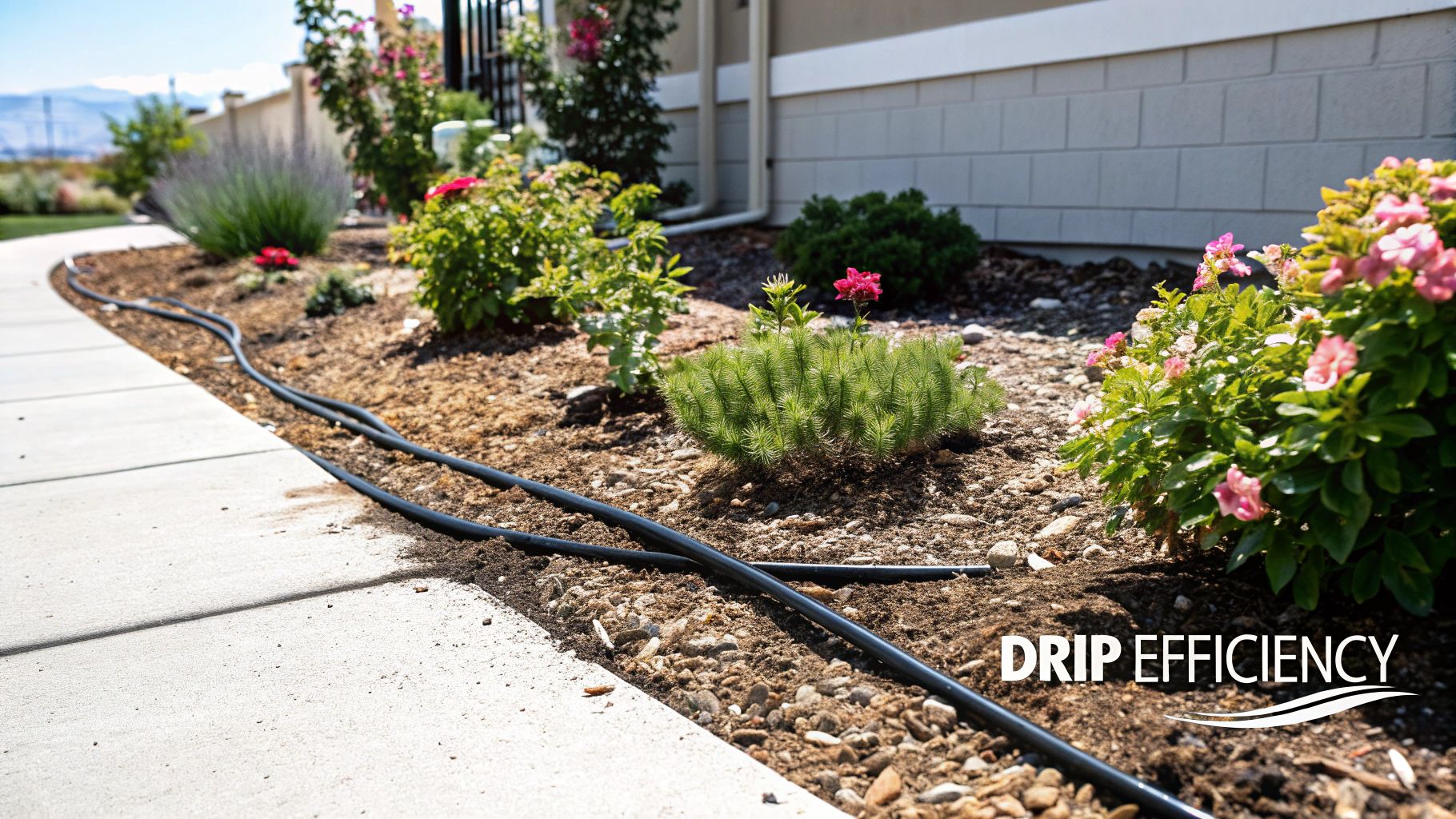
This summary highlights how drip irrigation, especially when enhanced with smart technology, offers a precise, highly efficient watering solution that is critical for sustainable, drought-tolerant landscaping.
10. Shade Trees and Strategic Planting
Incorporating shade trees into your landscape is a powerful, long-term strategy for creating a more water-wise and energy-efficient environment. By strategically placing drought-tolerant trees, you can create microclimates that reduce ambient temperatures by 10-20°F. This cooling effect decreases soil moisture evaporation and reduces the water needs of surrounding understory plants, making it one of the most effective drought tolerant landscaping ideas.
The impact of strategic tree planting is well-documented. Sacramento's "street tree master plan" successfully lowered urban heat island effects by 8°F, while studies in Phoenix show neighborhoods with mature tree canopies use 25% less energy for cooling. These examples prove that selecting the right trees provides significant benefits beyond aesthetics, actively reducing your home's resource consumption.
Key Principles for Strategic Planting
To maximize the benefits of shade trees, consider these essential implementation tips:
- Prioritize Placement: Plant deciduous trees on the west and south sides of your home to block intense summer sun while allowing warming sunlight in the winter.
- Increase AC Efficiency: Position a tree to shade your outdoor air conditioning unit, which can improve its efficiency by up to 10%.
- Plan for Growth: When considering the best trees to plant near your house, ensure you allow 15-20 feet of clearance from foundations and power lines for large species to prevent future issues.
- Choose Deep-Rooted Species: Select trees with deep root systems to minimize damage to sidewalks and patios.
- Mulch Generously: Apply a 2-4 inch layer of organic mulch around the base, keeping it away from the trunk, to conserve moisture and regulate soil temperature.
- Establish Properly: Water new trees deeply but infrequently during the first two seasons to encourage deep root growth and establish drought resilience.
Drought-Tolerant Landscaping Ideas Comparison
| Item | Implementation Complexity 🔄 | Resource Requirements ⚡ | Expected Outcomes 📊 | Ideal Use Cases 💡 | Key Advantages ⭐ |
|---|---|---|---|---|---|
| Xeriscaping | High - requires extensive planning and design expertise | Moderate to high - professional installation $8-15/sq ft | 50-75% water reduction, lower maintenance cost, increased property value | Arid/semi-arid areas with water restrictions and low-maintenance needs | Significant water savings, supports native wildlife, year-round visual interest |
| Native Plant Gardens | Moderate - needs local plant knowledge and site-specific planning | Low to moderate - plants may be rare or specialized | Up to 90% water reduction, supports biodiversity and wildlife habitats | Homeowners and landscapers focusing on ecological restoration and minimal upkeep | Minimal watering after establishment, preserves biodiversity, low maintenance |
| Succulent and Cactus Gardens | Moderate - requires careful soil preparation and site acclimation | Low to moderate - plants vary in cost, some mature specimens expensive | Extremely drought tolerant, unique architectural appeal, low maintenance | Frost-free or mild climates, gardeners seeking sculptural, low-water plants | Exceptional drought tolerance, minimal pruning, long-lived plants |
| Artificial Turf Installation | Moderate - professional installation with base preparation needed | High upfront - $5-20 per sq ft installed, ongoing maintenance | Eliminates water use for lawns, consistent year-round green appearance | High-traffic areas, pet runs, drought-prone urban landscapes | Zero watering, no mowing, all-season aesthetics, allergy reduction |
| Gravel and Rock Gardens | Moderate - requires site prep and design for stone placement | Low to moderate - materials $2-8 per sq ft | Zero irrigation, low maintenance, durable, excellent drainage | Dry landscapes, minimalist or rock-themed gardens, hardscape focal points | Zero water use, instant finish, cost-effective, heat-reflective hardscape |
| Mediterranean Garden Design | Moderate - plant selection and seasonal maintenance required | Moderate - plants and materials vary, establishment watering | Thrives in hot, dry climates, year-round structure, culinary and sensory benefits | Mediterranean climates (USDA 8-10), culinary herb gardens, sensory landscapes | Adapted to drought with aromatic herbs, quick establishment, evergreen structure |
| Rainwater Harvesting Systems | Variable - from simple barrels to complex cistern setups | Moderate to high - $500-$15,000+ depending on system size | Provides free irrigation water, reduces municipal demand, emergency supply | Drought-prone areas, water-conscious property owners, large or small properties | Reduces water bills, stormwater control, scalable, rebate incentives |
| Hardscaping and Permeable Paving | High - requires professional installation and structural work | High upfront - $10-50 per sq ft depending on materials | Zero irrigation for hardscaped areas, stormwater runoff reduction | Outdoor living spaces, urban yards, erosion-prone or high-traffic sites | Expands usable space, durable, reduces runoff, low maintenance |
| Drip Irrigation and Smart Controllers | Moderate - system design and installation needed, smart tech setup | Moderate - $1.50-4 per sq ft, plus smart controller costs | 30-70% water savings, precise watering, disease reduction | Landscapes needing efficient irrigation, varied plant water needs | High water efficiency, automation, weed control, rebate eligible |
| Shade Trees and Strategic Planting | Moderate - requires expert tree selection and placement | Low to moderate - tree cost and initial watering | 10-20°F ambient temperature reduction, cooling cost savings, habitat creation | Urban and suburban properties seeking microclimate benefits | Long-term cooling, evapotranspiration benefits, increased property value |
Start Your Water-Wise Transformation Today
Embracing drought-tolerant landscaping is more than just a passing trend; it's a strategic shift towards creating a sustainable, resilient, and stunningly beautiful outdoor space. We've explored a wide spectrum of powerful ideas, from the foundational principles of xeriscaping and the ecological wisdom of native plant gardens to the structural elegance of hardscaping with permeable pavers. Each concept offers a unique pathway to reducing water consumption while elevating your property's aesthetic and functional value.
The journey to a water-wise garden is not about restriction, but about smart, creative choices. It’s about understanding that a lush, vibrant landscape doesn't have to depend on constant irrigation. By integrating elements like gravel gardens, Mediterranean design principles, and strategic shade trees, you create a cohesive ecosystem that works with your local climate, not against it. The key takeaway is that these are not isolated strategies but interconnected components of a larger, more intelligent design philosophy.
Synthesizing Your Landscaping Vision
The true power of these drought tolerant landscaping ideas emerges when you begin to combine them. Imagine a garden where a dry creek bed of river rocks meanders through a tapestry of sculptural agaves and golden barrel cacti, all sustained by a discreet drip irrigation system. Picture a permeable flagstone patio shaded by a native Palo Verde tree, with rainwater from your roof collected in stylish barrels to nourish nearby container gardens.
This synthesis is where your unique landscape comes to life. It’s about building a multi-layered, visually interesting environment that is as practical as it is beautiful.
- Start with Structure: Begin by defining your hardscaping elements like patios, walkways, and rock gardens.
- Layer in the Greenery: Introduce your anchor plants, such as shade trees and large architectural cacti, to create focal points.
- Fill with Texture and Color: Add succulents, native grasses, and perennials to fill in the spaces, creating depth and year-round interest.
- Implement Smart Systems: Integrate efficient watering solutions like drip lines and smart controllers to automate and optimize water use.
Your Actionable Path Forward
Transforming your landscape can feel like a monumental task, but it begins with a single, decisive step. Your first move doesn't have to be a complete overhaul. Start by identifying the thirstiest section of your current yard, often a patch of traditional lawn, and commit to converting it into a water-wise feature. This could be a small succulent and cactus garden or a simple gravel bed with a few statement plants.
This incremental approach allows you to learn, adapt, and build confidence as you go. As you witness the dramatic reduction in your water bill and the minimal maintenance required, you'll be inspired to expand your vision. A successful drought-tolerant landscape is a testament to thoughtful planning and a commitment to a more sustainable future, proving that conservation and curb appeal can go hand in hand. You are not just planting a garden; you are cultivating a responsible legacy.
Ready to find the perfect architectural centerpiece for your new landscape? The incredible variety of cacti and succulents at The Cactus Outlet provides the sculptural beauty and unmatched resilience needed for any drought-tolerant design. Explore our collection online at The Cactus Outlet to discover the statement pieces that will bring your water-wise vision to life.

